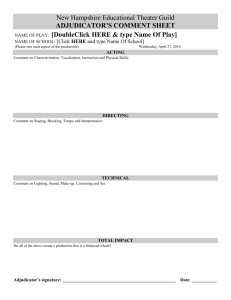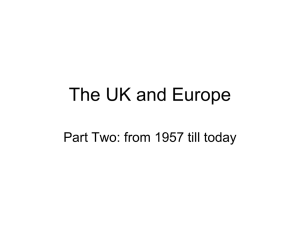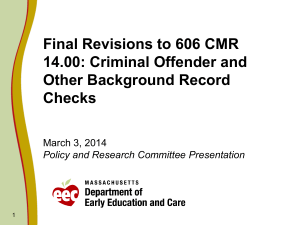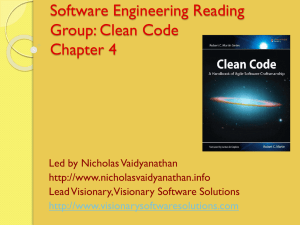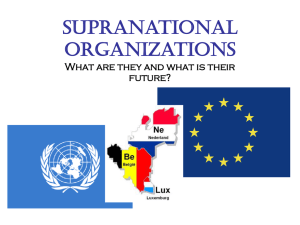Participant comment matrix for September 8, 2010 update
advertisement
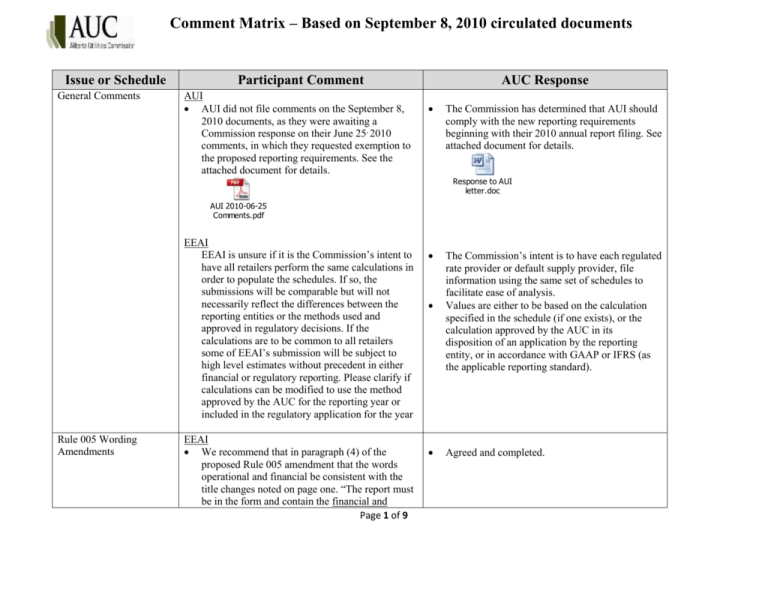
Comment Matrix – Based on September 8, 2010 circulated documents Issue or Schedule General Comments Participant Comment AUI AUI did not file comments on the September 8, 2010 documents, as they were awaiting a Commission response on their June 25, 2010 comments, in which they requested exemption to the proposed reporting requirements. See the attached document for details. AUC Response The Commission has determined that AUI should comply with the new reporting requirements beginning with their 2010 annual report filing. See attached document for details. Response to AUI letter.doc AUI 2010-06-25 Comments.pdf EEAI EEAI is unsure if it is the Commission’s intent to have all retailers perform the same calculations in order to populate the schedules. If so, the submissions will be comparable but will not necessarily reflect the differences between the reporting entities or the methods used and approved in regulatory decisions. If the calculations are to be common to all retailers some of EEAI’s submission will be subject to high level estimates without precedent in either financial or regulatory reporting. Please clarify if calculations can be modified to use the method approved by the AUC for the reporting year or included in the regulatory application for the year Rule 005 Wording Amendments EEAI We recommend that in paragraph (4) of the proposed Rule 005 amendment that the words operational and financial be consistent with the title changes noted on page one. “The report must be in the form and contain the financial and Page 1 of 9 The Commission’s intent is to have each regulated rate provider or default supply provider, file information using the same set of schedules to facilitate ease of analysis. Values are either to be based on the calculation specified in the schedule (if one exists), or the calculation approved by the AUC in its disposition of an application by the reporting entity, or in accordance with GAAP or IFRS (as the applicable reporting standard). Agreed and completed. Comment Matrix – Based on September 8, 2010 circulated documents Issue or Schedule Participant Comment AUC Response operational information set out in schedules:” Schedule A Purpose of schedules Schedule 1 Regulated Rate Tariff / Default Rate Tariff income statement EEAI We recommend lines 4-8 should be in order of schedules. Line 5 – flow-through expenses – is linked to Schedule 2 not Schedule 11; the formula should be corrected. Schedule 2 The reconciliation in lines 11-13 does not reconcile to net income but rather a variation of regulatory net income. We recommend that Line 13 be renamed to Adjusted Regulatory Net Income/(Loss). EEC Line 5: Flow Through Expenses are derived from Schedule 2 Flow Through Revenues. These costs theoretically are Flow Through. However, each year for various reasons, Flow Through Expenses exceed Flow Through Revenues. For example, Service Orders are a flow through revenue but not necessarily every service call can be passed onto the customer. Therefore, the formula linking to Schedule 2 Revenues means that the Flow Through Expenses are understated. Flow Though Expenses need to be independent of Flow Through Revenue. EEAI Page 2 of 9 Agreed and completed. Agreed and completed. Agreed. Line renamed “Adjusted regulatory net income/(loss)” Agreed. See bullet above. Comment Matrix – Based on September 8, 2010 circulated documents Issue or Schedule Participant Comment Revenue by customer class Please clarify if variance explanations are to be by class or by total. DERS Revenues identified by residential or commercial, a large portion of the revenues are tracked by these two categories (from our ITEK reports) but on a monthly basis accruals are made (examples DRT – DGA accrual at month end which does not separate by customer type, DRT/RRT admin revenue adjustments, and DRT/RRT T&D accruals) which are not identified by customer type just gas and power. These adjustments are made at the consolidated level. You can call this unallocated (a third column) and add a line item to the schedule. We should discuss this issue. Schedule 3 Sites and energy sales by customer class Schedule 4 Energy and operation expenses EEAI Please clarify if variance explanations are to be by class or by total. DERS Energy sales “accrued” by customer type. Accrue energy sales by gas or power not by customer class. During discussions on the Rule 005 schedules, the regulated rate providers indicated that they expense their electricity purchases based on a transfer price paid to a related trading entity or business unit. Page 3 of 9 AUC Response By total. The Commission requests that DERS prorate the accrued amount between the residential and commercial customer classes. Because the schedules are based on annual results only the December accrual would be included in the values, and the AUC considers that the significance of the estimation error would be minimal. By total. The Commission requests the accrual to be prorated by customer class. The Commission initiated further one on one meetings with the three regulated rate providers to explore this matter further. The attached document provides the attendees and dates along with a summary of the meetings. Comment Matrix – Based on September 8, 2010 circulated documents Issue or Schedule Participant Comment AUC Response Transfer price meeting notes.doc EEAI AUC administration fee and advisor/consultation costs are included in EEAI’s energy cost. Is it the Commission’s intent that EEAI should include these costs in Row 9 and exclude them from Rows 15 and 17? EEC Heading "Physical Spot Market" isn't reflective of how EEC procures energy. We would suggest that it be changed back to "Energy Purchases". Line 1 Description "AESO - Energy Charges." EEC purchases are not direct from AESO. Page 4 of 9 EEAI should report the AUC administration fee and the advisor / consultation costs in lines 15 and 17. This is because it is understood that the costs are incurred directly by EEAI and are not included in the price that EEAI pays for the energy. The Commission understands that EEAI’s RRT business unit pays a transfer price for electricity procurement services, as such; EEAI is directed to report the cost of these services on line 9 titled “Other electricity procurement costs”. The requirements for this line were updated in the template schedules, such that either the service agreement (if it exists) detailing the calculation and use of the transfer price is to be provided with the annual report filing, or a detailed explanation of how the transfer price calculation and its use, especially with regard to prior period adjustments and costs recovered in the energy rate, but expensed directly by EEAI. The Commission recognizes that EEC’s RRT business unit pays a transfer price for electricity procurement services, as such; EEC is directed to report the cost of these services on line 9 titled “Other electricity procurement costs”. The requirements for this line were updated in the Comment Matrix – Based on September 8, 2010 circulated documents Issue or Schedule Participant Comment AUC Response We would suggest that it be changed back to "Energy Purchases". Lines 2 - 5: As discussed in our meetings, EEC will not be populating these lines as they are not applicable to EEC. In preparing the schedules, we found that to make Schedule 11 work, we need to have a Schedule 8 Manpower Costs included in Schedule 4 (with Lines 10-18). EEC would suggest that Net Manpower Operating Expense be added as an Operating Expense line on Schedule 4. DERS DRT/RRT energy and operating expenses, no line item for “operational costs” which was included in the June draft. If you could explain the need for a detailed breakout of the RRT cost components as compared to the DRT schedule, one line - gas purchases. Suggest one line electricity purchases for the RRT. Suggest that the amended schedule revert back to the June draft format or even less disclosure. Do not see any benefit to the separation of physical and financial market costs. I would suggest having schedule 4 for DRT and RRT look the same to be consistent in the harmonization of the two reporting packages. Page 5 of 9 template schedules, such that either the service agreement (if it exists) detailing the calculation and use of the transfer price is to be provided with the annual report filing, or a detailed explanation of how the transfer price calculation and its use, especially with regard to prior period adjustments and costs recovered in the energy rate, but expensed directly by EEC’s RRT business unit. A new expense line titled ‘operational and administration costs’ was inserted into schedule 4 for both the DRT and RRT versions of the schedule. See preceding comment. The Commission recognizes that DERS’s RRT business unit pays a transfer price for electricity procurement services, as such; DERS is directed to report the cost of these services on line 9 titled “Other electricity procurement costs”. The requirements for this line were updated in the template schedules, such that either the service agreement (if it exists) detailing the calculation and use of the transfer price is to be provided with the annual report filing, or a detailed explanation of how the transfer price calculation and its use, especially with regard to prior period adjustments and costs recovered in the energy rate, but Comment Matrix – Based on September 8, 2010 circulated documents Issue or Schedule Participant Comment AUC Response expensed directly by DERS. Schedule 5 Debt capital employed and interest expense EEAI EEAI is not able to split interest associated with regulated and non-regulated debt as per line 9 as principal balances are not tracked in such a manner. As a proxy for interest expense, EEAI recovers Cost of Debt related to rate base in its revenue requirement. Should Row 11 equal the approved Cost of Debt and Row 10 equal the difference between total interest in Row 8 and Row 11? Schedule 6 Income taxes / Payment In Lieu Of Taxes (PILOT) EEAI EEAI calculates income tax for regulatory purposes using the Future Income Tax method. The Future Income Tax method does not account for differences between accounting and taxable income. Schedule A states the purpose of Schedule 6 is to” provide a breakdown of the actual calculations used to determine the expense related to deemed income tax or payment in lieu of taxes (PILOT) for the regulated operations of the provider”. Is EEAI correct in assuming the detail requested in Schedule 6 can be replaced by the calculation used in EEAI’s regulatory Yes To determine the actual costs of the operations to provide the RRT (or DRT) the Commission requires that actual expenses, where possible, including income tax expenses, be calculated and shown on a stand alone basis. This is consistent with recent directions.1 To remain consistent, the Commission has amended the purpose statement for this income tax schedule to the following. To provide the detailed tax calculation used to determine the income tax provision for the regulated operations of the provider, and to Decision 2010-483 – 2009-2011 Regulated Rate Option Non-Energy Tariff Application (Application 1605947, Proceeding ID. 521) (Released: October 7, 2010). Paragraph 145 “The Commission agrees with the CCA that the Calgary RRO must be treated as a stand- alone entity for regulatory purposes and for the purposes of calculating the PILOT component of its non-energy revenue requirements. Therefore, the Commission directs EEC to file in its compliance filing complete details regarding the allocations of PILOT payments to the Balancing Pool, split between the Calgary RRO and EEC’s non-regulated operations for 2008 and 2009 actuals, as well as the 2010 and 2011 forecast values.” 1 Page 6 of 9 Comment Matrix – Based on September 8, 2010 circulated documents Issue or Schedule Participant Comment AUC Response applications? EEC Lines 1 - 5: EEC will not be able to populate these lines because our PILOT Tax is not calculated based on RRO income. EEC's PILOT Taxes are based upon negotiated amounts that form part of a customer bill. EEC would still be able to populate Line 6 with the actual PILOT Expense as per the the RRO financial statements. Schedule 7 Capital assets continuity schedule EEAI EEAI does not split its assets into regulated and non-regulated categories and provides total capital balances for regulatory reporting purposes. Should EEAI complete Schedule 7 on the same basis it uses in its non-energy charge applications? Schedule 8 Manpower summary EEAI EEAI does not track FTE’s on a regulated/nonPage 7 of 9 explain the differences between the calculated income tax provision amount on schedule 6 and the amount expensed as income tax on schedule 1. In addition, an adjustment line was added to the schedule to account for any difference between the calculated income tax, and the amount expensed. See notes above for EEAI. Yes, EEAI should complete schedule 7 on the same basis as it uses in its non-energy charge applications. However to accommodate the fact that EEAI provides both regulated and unregulated assets on the schedule, the schedule was amended with adjusting line items 13 and 14 added to the accumulated depreciation section, to allow for the unregulated portion of the depreciation to be removed, such that the total depreciation expense recorded on the schedule will reconcile to that shown on schedule 1. EEAI should continue to complete this schedule Comment Matrix – Based on September 8, 2010 circulated documents Issue or Schedule Participant Comment AUC Response regulated basis, and all reporting for regulatory purposes includes total FTE’s. The instructions for this schedule indicate the FTEs should relate only to the RRT information in Rows 1 – 7. If EEAI populates Rows 8 – 14 with RRT-only information, it will not be comparable to the information included in EEAI’s non-energy charge filings. Does the Commission want the schedule populated with RRT-only information if this is a different basis than EEAI uses in regulatory filings? EEAI does not separately track contracted labour as per line 3, nor does it classify contractors as labour in its regulatory filings. Does the Commission want the schedule populated on the same basis that EEAI uses in regulatory filings? EEC Given that EEC only has 4 positions in this schedule, there is some concern regarding the appropriateness of disclosing these confidential (although aggregated) salary numbers in this manner. Schedule 9 Reserve accounts EEAI Should Schedule 9 include information on AUC approved reserve accounts only? Schedule 10 Affiliate transactions EEAI If the EEAI financial statements disclose related party transactions with non-affiliates for regulatory purposes, do the non-affiliate Page 8 of 9 in a manner consistent with how it files its nonenergy applications. Currently this means that all FTEs both regulated and unregulated should be shown. EEAI should continue to complete this schedule in a manner consistent with how it files its nonenergy applications. Currently this means that contracted labour would be excluded from this schedule. EEC should show the aggregate manpower (only) expenses and FTE’s consistent with how EEC showed the operational FTEs in Table 4.10 of its March 1, 2010 non-energy application #1605947. Yes. The requirement is for EEAI to report affiliate transactions based on the definition of affiliate as per the EPCOR Utilities Inc. inter-affiliate code of Comment Matrix – Based on September 8, 2010 circulated documents Issue or Schedule Participant Comment AUC Response transactions need to be included in Schedule 10? Schedule 11 Reconciliation of regulatory schedules to audited income statement Is Schedule 10 intended to detail rate regulated revenues and expenses only? EEAI Is Schedule 11 the only schedule requiring reconciliation to the financial statements or use of financial statement values as a starting point? We recommend that lines 2-5 should be combined to one line as per reference in Schedule 2. Detail can always be found in Schedule 2. Will there be a reconciliation of the disallowances to anything? Page 9 of 9 conduct. Yes Yes as all schedules should tie back to schedule 11. Agreed and completed. No, disallowances do not need to be reconciled to anything. However they are routinely the subject of audits by the AUC.

